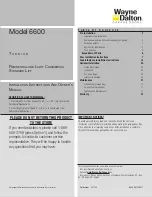
24
Please Do Not Return This Product To The Store.
Contact your local Wayne-Dalton dealer. To find your local Wayne-Dalton dealer, refer to your
local yellow pages/business listings or go to the
Find a Dealer
section online at
www.wayne-dalton.com
Tools Needed:
Rear Support continued...
NoTe:
If rear supports are to be installed over
drywall, use 5/16” x 2” hex head lag screws, and
make sure lag screws engaged solid structural
lumber.
NoTe:
Angles must be attached to sound framing
members and nails must not be used.
Now, permanently attach the weather seal to both
door jambs and header. (Temporarily attached in
PREPARING ThE OPENING on page 6). Avoid pushing
weather seal stop too tightly against face of door.
Place the miami-dade and the windload labels on the
intermediate section, as shown.
NoTe:
Windows will cause the top section to be
significantly heavier than the remaining sections.
Wayne-Dalton attempts to balance the door at the top
and bottom. To prevent any sudden door acceleration
between the top & bottom, we recommend motor
operating all top section windowed doors. Doors
with windows in top sections should not be manually
operated.
PRIOR TO WINDING OR MAkING ADjUSTMENTS TO
ThE SPRINGS, ENSURE YOU’RE WINDING IN ThE
PROPER DIRECTION AS STATED IN ThE INSTALLATION
INSTRUCTIONS. OThERWISE, ThE SPRING fITTINGS
MAY RELEASE fROM SPRING If NOT WOUND IN ThE
PROPER DIRECTION AND COULD RESULT IN SEVERE
OR fATAL INjURY.
Now, lift door and check its balance. Adjustments
to the required number of turns stated may be
necessary. If door raises off floor under spring tension
alone, reduce spring tension until door rests on the
floor. If the door is hard to raise or drifts down on
its own, add spring tension. A poorly balanced door
can cause garage door opener operation problems.
To adjust spring tension, fully close door. Apply vice
clamps to both vertical tracks above third roller.
Insert a winding bar into the winding cone. On single
spring doors, cable tension must be maintained by
placing vice grips on torsion tube before loosening
set screws in the winding cone. Push upward on the
winding bar while carefully loosening the set screws
in the winding cone.
BE PREPARED TO SUPPORT ThE fULL fORCE Of
ThE TORSION SPRING ONCE ThE SET SCREWS ARE
LOOSE.
Carefully adjust spring tension 1/8 to 1/4 turn.
Retighten both set screws in the winding cone and
repeat for the other side. REChECk DOOR BALANCE
DO NOT ADjUST MORE ThAN 1/2 TURN fROM ThE
RECOMMENDED NUMBER Of TURNS.If the door
still does not operate easily, lower the door into
the closed position, UNWIND ThE SPRING(S) fULLY
(Reference the insert “Removing The Old Door/
Preparing The Opening” section on torsion spring
removal), and recheck the following the items:
1.) Check the door for level.
2.) Check the torsion tube for level.
3.) Check the track spacing.
4.) Check the counterbalance cables for equal
tension.
5.) Check the track for potential obstruction of the
rollers.
6.) Clamp vice clamps onto tracks and rewind
springs.
imPoRTaNT:
If DOOR STILL DOES NOT OPERATE
PROPERLY, ThEN CONTACT A TRAINED DOOR SYSTEM
TEChNICIAN.
Perforated angle
(3)
5/16”-18 x 1-1/4”
hex bolts and
(3)
5/16”-18 nuts
(3)
5/16”-18
Nuts
horizontal
track
Perforated angle
Perforated angle - bolted using (2)
5/16” x 1-5/8” hex head lag screws
to ceiling member and parallel to
width of door. Space lag screws no
further than 24” apart.
Sound framing
members
Bolt must extend into the
track to serve as a roller stop
24”
Bolt must extend into the track
to serve as a roller stop
Sound framing members
horizontal
track
Perforated angle
Perforated angle -bolted using
(2) 5/16” x 1-5/8” hex head
lag screws to ceiling members
and parallel to width of door.
Attach vertical perforated angle
between the (2) 5/16” x 1-5/8”
hex head lag screws, securing
perforated angle to ceiling
members.
waRNiNg
3/4” to 7/8”
Door edges
horizontal tracks
Intermediate
section
Windload
label
Miami-dade
label
3/4” to 7/8”
waRNiNg





































